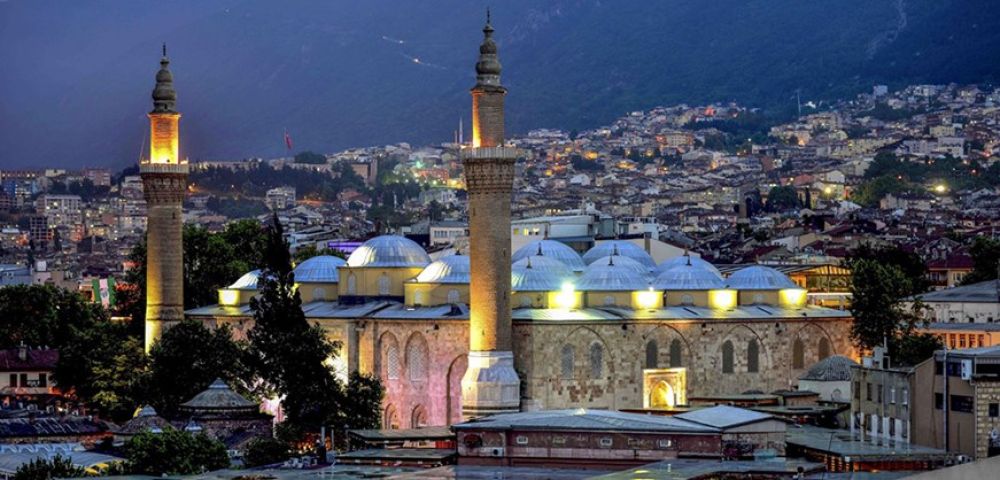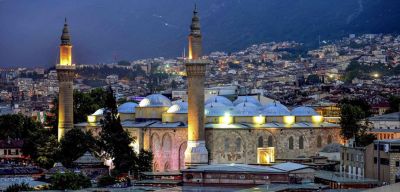

Embark on a guided historical tour of Ulu Cami, the Grand Mosque of Bursa, which stands as a monumental piece of early Ottoman architecture. Constructed between 1396 and 1400 under the order of Sultan Bayezid I, the mosque features a multi-domed and pillar aesthetic that is a departure from the traditional basilica structure. Inside, explore 20 domes arranged in four rows with 12 enormous pillars, giving an insight into the grandeur of the Ottoman Empire's early period. The mosque houses some of the most exquisite Islamic calligraphy, including the work of the famous Ottoman calligrapher Ali bin Hilal, known as Amasyal? Karamemi. Admire the grand calligraphic inscriptions that adorn the walls, columns, and ceilings, including the 192 monumental inscriptions which showcase verses from the Quran. Notice the mosque's fountain under the open sky, where worshippers once performed their ritual ablutions. The guided tour provides historical context to the mosque's design, its significance in the Islamic world, and its role in the community.
Discover the architectural marvels of Ulu Cami during this thematic walk, focusing on its distinctive elements that reflect the transitional phase of Anatolian mosque architecture. Visitors can delve deeper into the structure's main characteristics, such as the grand iron gates, the intricate mihrab and minbar, and the overall harmonious proportions that give a sense of spaciousness and light. The mosque's 20 domes rest on thick walls supported by 12 massive columns, forming a basilica-like plan unusual for Ottoman mosque structure. During the walk, participants will learn about the Seljuk influence, the incorporation of Byzantine elements, and the innovations that foretell the classical Ottoman style that came to fruition in the following century. The Architecture Appreciation Walk is a must for those keen on understanding the mosque's place in the evolution of Islamic architecture and the blend of styles that make Ulu Cami a masterpiece.
Photography enthusiasts can capture the timeless beauty of Ulu Cami with its awe-inspiring interior and exterior details. The Grand Mosque's high ceilings adorned with calligraphy, the geometric designs of the tiled mihrab, and the unique lighting created by its 20 domes offer countless photographic opportunities. This activity does not have a specific duration, as photographers can spend as long as they like framing their shots and finding the perfect angles. Early morning light provides a soft glow that enhances the intricate details, while the late afternoon sun brings a golden ambiance to the spiritual space. Keep in mind the importance of respecting the sanctity of the mosque and, if other worshippers are present, make sure to seek permission and avoid obstructing their practices.
Take part in a cultural workshop at Ulu Cami to gain hands-on experience with traditional Turkish arts and crafts. Workshops may include Ebru (marble painting), calligraphy, or the making of rosaries and prayer beads, which are profoundly tied to the historical context of the mosque. Participants can learn from local artisans, who explain the historical significance of their crafts and guide them through the creation process. These workshops offer a perfect blend of education and entertainment and provide a take-home memento of the visit. The duration of the workshop generally covers the time required to introduce the craft, demonstrate the techniques, and allow participants to create their own artwork with assistance from the artisans.
The calligraphy exhibition within Ulu Cami is a tribute to the historical significance of Islamic art. Visitors have the opportunity to admire an expansive collection of Islamic calligraphy that includes verses from the Quran, hadiths, and aphorisms rendered in various calligraphic styles such as Thuluth, Naskh, and Diwani. The exhibition tour tells the story behind important pieces, the life and works of renowned calligraphers, and the evolution of calligraphy in Islamic culture. Pieces on display often feature intricate borders and are frequently illuminated with gold leaf and vibrant colors that highlight the artistic craftsmanship. Attendees will learn about the materials and tools used in the creation of these works, like traditional reed pens (qalams) and handmade papers.
